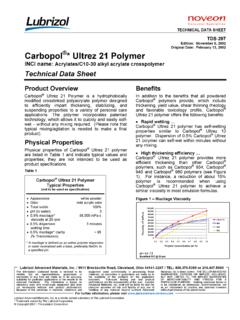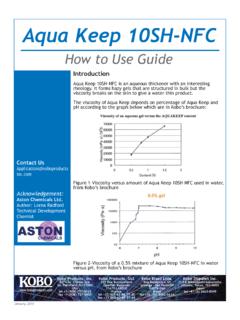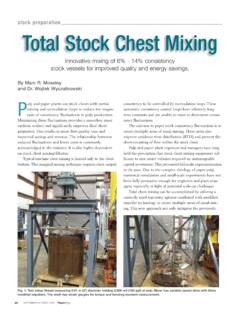Transcription of Thermorheological properties of LLDPE/LDPE blends
1 ORIGINAL CONTRIBUTIONT hermorheological properties of LLDPE/LDPE blendsO. Delgadillo-Vel zquez&S. G. Hatzikiriakos&M. SentmanatReceived: 9 November 2006 /Accepted: 2 April 2007 / Published online: 7 May 2007#Springer-Verlag 2007 AbstractThe Thermorheological behavior of a number oflinear low-density polyethylene and low-density polyethyl-ene ( LLDPE/LDPE ) blends was studied with emphasis onthe effects of long chain branching. A Ziegler Natta, lldpe ( ) was blended with four LDPEs having distinctlydifferent molecular weights. The weight fractions of theLDPEs used in the blends were 1, 5, 10, 20, 50, and 75%.
2 Differential scanning calorimetry (DSC) analysis has shownthat all blends exhibited more than one crystal type. At highLDPE weight fractions, apart from the two distinct peaks ofthe individual components, a third peak appears whichindicates the existence of a third phase that is created fromthe co-crystallization of the two components. The linearviscoelastic characterization was performed, and master-curves at 150 C were constructed for all blends to checkmiscibility. In addition, Van Gurp Palmen, zero-shear viscos-ity vs composition, Cole Cole, and the weighted relaxationspectra plots were constructed to check the thermorheolog-ical behavior of all blends .
3 In general, good agreement isfound among these various methods. The elongationalbehavior of the blends was studied using a uniaxial exten-sional rheometer, the SER universal testing platform fromXpansion Instruments. The blends exhibit strain-hardeningbehavior at high rates of deformation even at ldpe concentrations as low as1%, which suggests the strongeffect of branching added by the ldpe blendIntroductionThe thermodynamic behavior of linear and branchedpolyethylene (BPE) blends using rheological methods hasbeen the subject of many studies (Yamaguchi and Abe1999; Lee and Denn2000; Liu et ; Ho et ;Hussein et ; Hussein and Williams2004a,b; Fanget ).
4 It has been reported that the thermorheologicaland processing properties of the blend are largely deter-mined by molecular parameters, which include: (1) longchain branching content (LCB), which is the number oflong branches, typically branches which have a number ofcarbon atoms more than 13 (Wagner et ; Kissin2005), (2) compositional distribution (CD), which is thenumber and length of long chain branches for a given LCBmacromolecule, or the amount and type of comonomer inthe case of lldpe (Gabriel and M nstedt2003; Husseinand Williams2004b; Fang et ; Kissin2005), (3)molecular weight,Mw(Hussein and Williams2004b;Gabrieland Lilge2006), and (4) molecular weight distribution(MWD; Dealy and Wissbrun1990).
5 Most studies agree that linear low-density polyethyleneand low-density polyethylene ( LLDPE/LDPE ) are miscibleblends at low ldpe contents, which become immiscible athigher ldpe (Lee and Denn2000; Ho et ). Hexenecomonomer promotes immiscibility (Hussein et ;Hussein and Williams2004b), whereas octene comonomerpromotes miscibility (Fang et ). In addition, lowmolecular weight LLDPEs promote miscibility better thanhighMwones (Hussein and Williams2004a). In a recentreview, Zhao and Choi (2006) have reported that lldpe /Rheol Acta (2008) 47:19 31 DOI Delgadillo-Vel zquez:S. G. Hatzikiriakos (*)Department of Chemical and Biological Engineering,The University of British Columbia,Vancouver, BC, Canadae-mail: SentmanatXpansion Instruments,Tallmadge, OH, USALDPE blends were immiscible in the melt state, with LCBbeing the determining factor of their immiscibility , Wagner et al.
6 (2004) performed a quantitativeanalysis of melt elongational behavior of LLDPE/LDPE blends . They have reported that the complex behavior ofthese blends can be understood by assuming the existence oftwo phases; one phase composed of the highly branched lowMwchains of both polyethylenes and a second phasecomposed of the highMwchains (mostly linear) of bothpolyethylenes. Differential scanning calorimetry (DSC)thermograms of LLDPE/LDPE blends reported by Fang etal. (2005) support the existence of a third phase composed ofchains from the two polyethylenes that have the ability to co-crystallize; additionally, enhancement in the crystallizationbehavior of BPE blended with linear polyethylene (LPE) wasexplained in terms of co-crystallization due to the incorpo-ration of the linear segments of BPE into rich-LPE lamellaeand the segregation of the most branched chains (Puig2001).
7 The LLDPE/LDPE blend miscibility studies mentionedabove make use of thermal techniques, such as DSC, andrheometrical techniques, such as linear viscoelasticity ofblends at different temperatures (Van Gurp and Palmen1998; Mavridis and Shroff1992; Hatzikiriakos2000).Failure of time temperature superposition can be interpretedas an immiscibility criterion (Van Gurp and Palmen1998;Pe n et ; Wagner et ; P rez et ).Positive deviation of zero shear rate viscosity from the log-additivity-mixing rule is also an indication of immiscibility(Lee and Denn2000; Liu et ; Hussein et ).The Cole Cole plot, representation between the imaginary( 0) and real part ( 00) of the complex viscosity, has beenused by several authors as criteria for miscibility in poly-ethylene blends (Kim et ; Ho et ).
8 The determination of the weighted relaxation spectrabased on linear viscoelasticity is another method used toinfer the Thermorheological behavior of polyethyleneblends. The spectra have been used to determine whetherthe blend components are immiscible due to an additionalrelaxation mechanism associated with interfacial tension(Gramespacher and Meissner1992; Lacroix et ;Fang et ).In this paper, we study systematically the thermorheo-logical behavior of a lldpe with four LDPEs that haveviscosity curves that lie above, about the same, and belowthat of the lldpe . The miscibility of the various blends isstudied with DSC and linear viscoelastic measurementswith the application of several Thermorheological complex-ity criteria [time temperature superposition (TTS), VanGurp plot, Cole Cole plot, zero-shear viscosity vs compo-sition, and relaxation spectrum].
9 All the methods are com-pared to check consistency of the results. The extensionalrheological properties of the blends are also studied toexamine the effects of and methodsPolyethylene resins and blendsThe lldpe resin used in this study was a Ziegler Natta,hexene copolymer, supplied by ExxonMobil (LL3001). TheLDPE resins used in this work are LD200 by ExxonMobil,EF606A by Westlake Polymers, and 662I and 132I providedby Dow Chemicals. Table1lists all the polymers usedalong with their melt indices and densities. The ldpe resins have been labeled as ldpe -I to ldpe -IV in theorder of decreasing melt index lldpe resin was melt-blended respectively witheach ldpe resin to create LLDPE/LDPE blends havingweight compositions of 99:1, 95:5, 90:10, 80:20, 50:50, and25:75.
10 The blending was performed as follows: Theoriginal components were mixed and ground in a Brabrendermixer to reduce their pellet size. Then, the mixture in theform of flakes was blended into a single screw extruder, atlow processing speed (3 4 rpm), using a screw havingmixing elements near to the end of the metering zone. Thetemperature of the die was kept at 160 C. The extrudateswere then pelletized for easy handling. The blend 99:1 wasproduced in two dilution steps, the first being the 95 analysisA Shimadzu DSC-60 calorimeter was used to study thethermal behavior of the pure components and their were made on samples of about 1 2mgsealedin aluminum pans and nitrogen flow.





